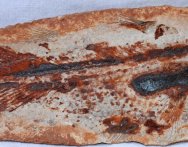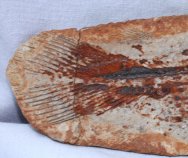Whiteia
woodwardi
Class Sarcopterygii,
Subclass Actinistia, Order Coelacanthiformes, Family Whiteidae
Geological
Time: Early Triassic (~240 m.y.a.)
Size: Fish
fossil is 125 mm long Matrix: 130 mm by 45 mm
Fossil Site:
Karroo Formation, Anaborana, Madagascar
|  Description:
A fine example of a half nodule from the early Triassic
of Madagascar containing most of a very detailed coelacanth known
as Whiteia woodwardi. The coelacanths reached the height of their
diversity during the Carboniferous and were thought to have become
extinct by the end of the Cretaceous until a Description:
A fine example of a half nodule from the early Triassic
of Madagascar containing most of a very detailed coelacanth known
as Whiteia woodwardi. The coelacanths reached the height of their
diversity during the Carboniferous and were thought to have become
extinct by the end of the Cretaceous until a  lone
living fish was discovered off the coast the Comoro Islands in
the late 1930s.
Subsequent specimens of the modern genus Latimeria have been
discovered off the coast of Africa and in Indonesia. This one
displays the characteristic double dorsal fin of the coelacanths
and is nearly complete, dominating its half nodule. Interestingly,
although most fossil nodules display a part/counterpart specimen,
these show the preservation of the impression of opposite sides
of the specimen. The repaired crack passing through the caudal
fin detracts but little from this realy-offered taxon. lone
living fish was discovered off the coast the Comoro Islands in
the late 1930s.
Subsequent specimens of the modern genus Latimeria have been
discovered off the coast of Africa and in Indonesia. This one
displays the characteristic double dorsal fin of the coelacanths
and is nearly complete, dominating its half nodule. Interestingly,
although most fossil nodules display a part/counterpart specimen,
these show the preservation of the impression of opposite sides
of the specimen. The repaired crack passing through the caudal
fin detracts but little from this realy-offered taxon.
|
|





